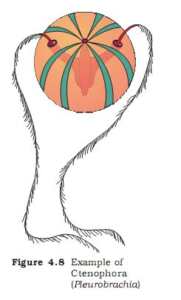Animal Kingdom MCQ/objective questions Class 11 Biology Chapter 4
1. Sponges exhibit:
- a. The cellular level of organization.
- b. Multicellular level of organization.
- c. Acellular level of organization.
- d. None.
2. Tissue level organization is first seen in:
- a. Coelenterates.
- b. Platyhelminthes.
- c. Nematahelminthes.
- d. Arthropods.
3. The organ level organization is first seen in:
- a. Concentrates.
- b. Platyhelminthes.
- c. Nematahelminthes.
- d. Arthropods.
4. Following is a diploblastic animal:
- a. Concentrates.
- b. Platyhelminthes.
- c. Nematahelminthes.
- d. Arthropods.
5. Following is/are a triploblastic animal:
- a. Concentrates.
- b. Platyhelminthes.
- c. Nematahelminthes.
- d. b and c.
6. Coelom of coelentrates is a:
- a. True coelom
- b. False coelom.
- c. None.
7. Non-chordates is:
- a. Porifera to Platyhelminthes.
- b. Porifera to annelids.
- c. Porifera to echinoderms.
- d. None.
8. Faetures of protists are:
- a. Both sexes present (hermaphrodite).
- b. Numerous pores for food intake (Ostia).
- c. A central cavity (Spongocoel)
- d. All of the above.
9. Features of coelenterates is/are:
- a. False coelom.
- b. Mostly marine.
- c. Alternation of generation (Metagenesis)
- d. All of the above.


- a. Porifera.
- b. Ctenophora.
- c. Platyhelminthes.
- d. Nemtahelminthes.
11. Flatworms belong to phylum:
- a. Platyhelminthes.
- b. Nemtahelminthes.
- c. Ctenophora.
- d. Annelids.
12. Examples of platyheminthes are:
- a. Planaria.
- b. Taenia (tapeworm).
- c. Fasciola (Liver-fluke).
- d. All three.
13. We see high regeneration capacity in:
- a. Planaria.
- b. Taenia (tapeworm).
- c. Fasciola (Liver-fluke).
- d. All three.
14. Examples of aschelminthes are:
- a. Ascaris (roundworm).
- b. Wuchereia (filaria worm).
- c. Ancylostoma (hookworm).
- d. All three.
13. Largest phylum of Animalia which cover two-thirds of all species on the earth is:
- a. Platyhelminthes.
- b. Nematahelminthes.
- c. Arthropods.
- d. Chordates.
16. Arthopod means:
- a. Jointed appendages.
- b. Bent legs.
- c. Quadriceps.
- d. Insect.
17. Excettion in arthropods takes place through:
- a. Kidneys.
- b. Gills.
- c. Malpighian tubules.
- d. Lungs.
18. Second-Largest phylum of Animalia is:
- a. Platyhelminthes.
- b. Nematahelminthes.
- c. Arthropods.
- d. Mollusks.
19. Spiny bodied animal belong to:
- a. Echinoderm.
- b. Chordata.
- c. Arthropods.
- d. Mollusks.
20. The peculiar feature of echinoderm is:
- a. Closed vascular system.
- b. Blood vascular system.
- c. Water vascular system.
- d. Digestive system.
21. Connecting ling between chordates and non-chordates is:
- a. Hemichordata.
- b. Urochordata.
- c. Echinoderm.
- d. None.
22. Chordate include:
- a. Fishes.
- b. Birds.
- c. Reptiles.
- d. Mammals.
- e. All four.
Next:
- The Living world MCQ Biology Questions
- Biological Classification MCQ Questions with answers
- Plant Kingdom MCQ Biology Class Eleven
- Animal Kingdom MCQ Biology
- Morphology of Flowering Plants MCQ
- Anatomy of Flowering Plants MCQ Biology
- Structural Organisation in Animals MCQ
Answers:
| 1. a | 9. d | 17. c |
| 2. a | 10. b | 18. d |
| 3. b | 11. a | 19. a |
| 4. a | 12. d | 20. c |
| 5. a | 13. a | 21. a |
| 6. b | 14. d | 22. e |
| 7. c | 15. c | |
| 8.d | 16. a |
Animal Kingdom MCQ/Objective questions Chapter 4 Biology Class 11
Ref: Chapter 4, NCERT.
Good
It was really helpful to me and other students just like me ,how just want to get a quick check of their revision